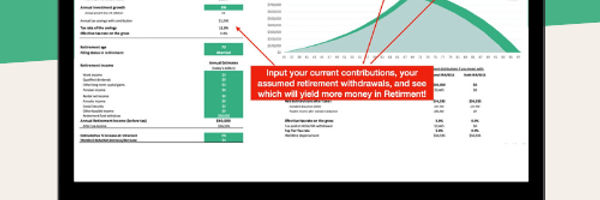If there is ever a critical time for retirement planning, it's when you hit your 50s. You still have ten to fifteen years left in the workplace, and you're entering your peak earning years.
With many of the larger expenses hopefully behind or winding down, it's time to do some serious number crunching and figure out what it's going to take to live comfortably in retirement.

Roth IRA or 401k? This template will answer your questions.
With this template, you will get:
All DFY, simply add your details
Charts for comparison and clear answer
Easily update for any year (2023, 2024, 2025, etc…)

Final Retirement Planning Opportunity
The 50s are really your final chance at creating a true retirement plan. Once you hit the 60s, there's simply not enough time left to make a plan. The good news is that many of the larger expenses such as a mortgage should be nearing their final payments, or are quite "affordable" by the time you leave your 50s. Research on salaries in the workplace tells us you're in the peak earning years too.
Realistically, there are probably two major groups of retirement planners in this particular age bracket:
Those that are evaluating their retirement plan to see if it is still working. This group really just needs to run through some calculations, and figure out if they need to save more aggressively.
Those that have held off, for whatever reason, putting together a retirement plan, and now want to get one started.

Roth IRA or 401k? This template will answer your questions.
With this template, you will get:
All DFY, simply add your details
Charts for comparison and clear answer
Easily update for any year (2023, 2024, 2025, etc…)

Example Retirement Plans
At this point, we think it's useful to look at a couple of examples of retirement scenarios that individuals in their 50s might find themselves in right now. In this example, we're going to look at two different individuals and talk about how well they might be positioned for retirement today.
Retirement Savings Examples
Current Age | 55 | 55 |
Desired Retirement Age | 65 | 65 |
Annual Household Income | $95,000 | $95,000 |
Anticipated Income Growth Rate | 3.0% | 3.0% |
Desired Income Replacement Rate | 70% | 70% |
Current Retirement Assets | $125,000 | $10,000 |
Expected Return on Investments | 6.0% | 6.0% |
Expected Pension at Retirement | $33,000 | $33,000 |
Social Security at Retirement | $30,000 | $30,000 |
Ongoing Annual Savings Required | $5,964 | $21,589 |
We prepared this example using our retirement savings calculator, and if you try to replicate these scenarios using that tool, you'll find some other interesting information. For example, these retirees both expect to be making nearly $128,000 when they reach their retirement age of 65.
They also want to make nearly $90,000 per year in retirement. To supply that level of income, they are depending on Social Security, a pension plan, and the funds in a retirement plan such as an Individual Retirement Account, 401(k) plan or 403(b). In both scenarios above, each retiree needs to have a little over $300,000 in their retirement account to supplement the income from their pension and Social Security.
The difference in these two examples is the current retirement assets each individual owns. One 55 year old has $125,000 saved, while the other only has $10,000. This retirement savings gap translates into $5,964 in required annual savings for one individual and $21,589 for the other; this is quite a difference.
Saving for Retirement
The point of this example is to demonstrate the large retirement planning difference that may exist between two 55 year olds. The first individual needs to continue to work their plan by saving nearly $6,000 per year. The second individual needs to make some significant financial sacrifices if they are going to reach their retirement savings goal of nearly $22,000 per year.
By age 50, you should have a very good idea of what it's going to take for you to live comfortably in retirement. You should also be near the end of your large financial commitments such as weddings, student loans, and paying off a mortgage. The fact that you're in the peak earning years and expenses should be declining means that you can get very aggressive, if necessary, with an annual retirement savings plan.

Roth IRA or 401k? This template will answer your questions.
With this template, you will get:
All DFY, simply add your details
Charts for comparison and clear answer
Easily update for any year (2023, 2024, 2025, etc…)

Retirement Planning Tools
If you're interested in creating "what-if" retirement scenarios, then take a closer look at some of the tools we have to offer, including:
Retirement Calculators: This section includes several retirement calculators designed to help users run through a variety of examples or planning scenarios.
Retirement Planning Guide: This article walks users through a series of questions aimed at helping them to decide where to start or continue their retirement savings.
Most individuals have two options when it comes to retirement savings: IRAs and employee sponsored savings plans such as 401(k) plans and 403(b) accounts. This second guide helps to figure out which retirement account you may want to fund first; if you have the need or the luxury of having a significant amount of disposable income.
Retirement Planning Strategies
This is actually the fourth publication in this retirement planning series. Our third publication - Retirement Planning in Your 40s detailed a very methodical approach to creating a retirement plan. That particular approach relied on the practice of using Plan, Do, Check, Act to create and monitor the progress of a particular plan.
If you're interested in learning how to put a retirement plan together, then you may want to take a look at that article. Listed below are some of the more important steps, and specific activities that a 50-something should consider when planning for retirement.
Consolidating Plans
If you've worked for several employers through the years, and you have a number of "smaller" plans with each employer, it might be time to consolidate these retirement plans. The benefit of consolidating plans is that it allows you to gain a better picture of what's happening with your total retirement portfolio, and makes managing the portfolio itself much easier.
Whether it's an IRA, or a 401(k) plan, it's a fairly common request to transfer one retirement account into another. Your plan administrators should be able to supply all the required paperwork. Be careful about taking personal ownership of the money, or it could be viewed by the IRS as an early withdrawal.
Take a look at our article on 401(k) Rollovers or 403(b) Rollovers for some helpful hints that should help you to avoid early withdrawal penalties that can be imposed by the tax code.
Balancing the Risk and Rewards of Investments
At this point in your life, the ideal retirement account should be a mix of stocks, bonds and shorter-term cash investments such as CDs. Make sure you're comfortable with the risk and rewards of each investment type. Generally, it is advisable to move money into "safer" investments the closer you get to the point in time when you actually need to use the money.
For example, you don't want all the money in highly volatile growth stocks in the same year you anticipate needing the money for income. It's never a good idea to close out a position in a stock when it's in the middle of a downswing.
Balancing a Portfolio
Once you've decided on the mix of stocks and bonds in your retirement portfolio, make sure you are looking at the percentage allocated to each type of investment at least once a year. As each asset class appreciates or declines in value, you may find it necessary to redirect future investments or rebalance the portfolio between asset classes.
Playing Catch-Up
Finally, if the need to play catch up arises, keep in mind that the IRS has some catch-up limits that apply to individuals 50 and older:
401(k) Plans: In 2020 and 2021 you can contribute up to $26,000 to a 401(k) plan, which includes a $6,500 catch-up limit. For more information on future limits, including those for 2022, take a look at our article: 401(k) Contribution Limits.
IRA (Including Traditional IRAs and Roth IRAs): In 2020 and 2021, you can contribute up to $7,000, which includes a catch up limit of $1,000, to a Traditional or Roth IRA. Once again, we also have information for 2022 in our articles on IRA Contribution Limits and Roth IRA Contribution Limits when it becomes available in mid to late October.
Finally, make sure you stay informed of the retirement planning options your company offers. Many companies are beginning to offer Roth 403(b) and Roth 401(k) plans that provide employees with benefits which go beyond more traditional choices.





